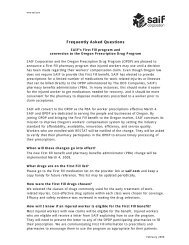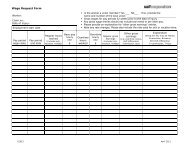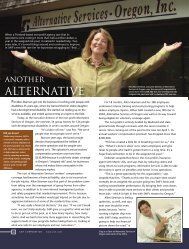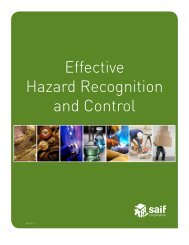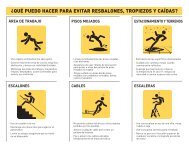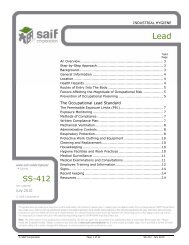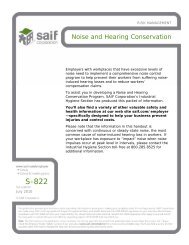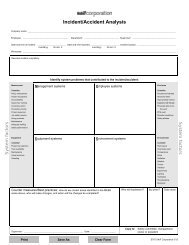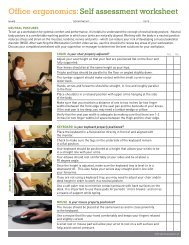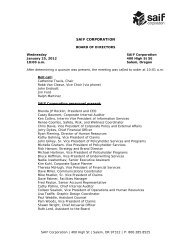Toolbox: Return-to-Work - SAIF Corporation
Toolbox: Return-to-Work - SAIF Corporation
Toolbox: Return-to-Work - SAIF Corporation
You also want an ePaper? Increase the reach of your titles
YUMPU automatically turns print PDFs into web optimized ePapers that Google loves.
RISK MANAGEMENT<br />
<strong>Return</strong> <strong>to</strong> <strong>Work</strong><br />
<strong>Return</strong>-<strong>to</strong>-<strong>Work</strong><br />
<strong>SAIF</strong> <strong>Corporation</strong> is committed <strong>to</strong> helping injured workers return<br />
<strong>to</strong> work as early as possible. If an injured worker cannot return<br />
immediately <strong>to</strong> regular work due <strong>to</strong> physical limitations or<br />
constraints, <strong>SAIF</strong> return-<strong>to</strong>-work consultants will work with the<br />
employer and the treating physician <strong>to</strong> return the injured worker<br />
<strong>to</strong> a transitional/temporary job. <strong>Return</strong>-<strong>to</strong>-work programs play a<br />
major role in controlling claim costs and save millions of dollars<br />
in reduced time-loss payments.<br />
A return-<strong>to</strong>-work program is an essential part of a company’s<br />
loss control efforts. It can reduce the <strong>to</strong>tal number of claims,<br />
contain workers’ compensation claim costs, and encourage<br />
workers <strong>to</strong> participate in the process, thus enhancing their<br />
awareness of safety and their responsibility in the recovery<br />
process. Proactive return-<strong>to</strong>-work efforts can be a pricing and<br />
selection advantage for those who perform post-loss cost<br />
containment activities. A sample written program is included in<br />
this section. As with any new written process, check with a legal<br />
professional before implementing, <strong>to</strong> ensure that it is consistent<br />
with your other written policies.<br />
A return-<strong>to</strong>-work program simply provides transitional/temporary<br />
jobs, approved by the injured worker’s physician, in order <strong>to</strong> bring<br />
the worker back <strong>to</strong> work at the earliest possible time rather than<br />
waiting for the worker <strong>to</strong> be released for normal work duties.<br />
Communication with all parties–the injured worker, the<br />
attending physician, company management, the immediate<br />
supervisor, and the insurance company–is crucial <strong>to</strong> the success<br />
of the program. There should also be a provision for moni<strong>to</strong>ring<br />
the transitional/temporary job, until the worker is released for<br />
normal work or the worker’s condition becomes medically<br />
stationary.<br />
© <strong>SAIF</strong> <strong>Corporation</strong> Page 1 of 25 S-825 January 2007
Risk Management <strong>Return</strong> <strong>to</strong> <strong>Work</strong><br />
www.saif.com<br />
Program benefits<br />
• Injured workers off work longer than six months have only a 50<br />
percent chance of returning <strong>to</strong> their job. If time loss exceeds one<br />
year, there is a 90 percent chance they will never return <strong>to</strong> work.<br />
• <strong>Return</strong>-<strong>to</strong>-work programs reduce medical costs. The injured worker<br />
heals faster, shortening the time medical treatment is required.<br />
• <strong>Return</strong>-<strong>to</strong>-work programs reduce legal costs. <strong>Work</strong>ers are less likely <strong>to</strong><br />
feel their rights have been violated causing them <strong>to</strong> hire legal council.<br />
• Cost reductions resulting from return-<strong>to</strong>-work programs directly<br />
impact your organization’s workers’ compensation premium rate.<br />
Manage the process<br />
The immediate supervisor serves a key role in making the process<br />
successful. Consistent and on-going communication with the worker is<br />
vital. The process should be treated in a positive, proactive fashion. The<br />
worker in a transitional/temporary job should be made <strong>to</strong> feel that he or<br />
she is a productive part of the work force. Care and concern should be<br />
expressed by all involved, including the worker’s peers. You should inform<br />
your claims adjuster and/or return-<strong>to</strong>-work consultant regarding any<br />
changes in the worker’s transitional/temporary work status.<br />
How <strong>to</strong> get your injured workers back <strong>to</strong> work and control workers’<br />
compensation costs<br />
1. Find a transitional/temporary job that fits the injury.<br />
Use your Release <strong>to</strong> <strong>Return</strong>-<strong>to</strong>-<strong>Work</strong> form (a sample is included in<br />
this section) or physician’s release form <strong>to</strong> determine the physician’s<br />
work restrictions. Then, if possible, identify a suitable<br />
transitional/temporary job within those restrictions. Provide a copy of<br />
this form <strong>to</strong> your worker and instruct the worker <strong>to</strong> have their physician<br />
complete the form at each visit and return it <strong>to</strong> you so that you may<br />
stay updated with their most current work restrictions.<br />
2. Do not wait for the physician <strong>to</strong> contact you.<br />
Write a description of the transitional job (using the Job Description<br />
form included in this section), identifying the physical requirements of<br />
your transitional/temporary position. When applicable, use the information<br />
previously obtained from your Release <strong>to</strong> <strong>Return</strong>-<strong>to</strong>-<strong>Work</strong> Form or<br />
other physician’s release information.<br />
Send the job description <strong>to</strong> the treating physician, introducing the job and<br />
expressing your willingness <strong>to</strong> accommodate the physical restrictions the<br />
physician identified. Offer <strong>to</strong> pick up the response, or provide a fax or<br />
contact number <strong>to</strong> the doc<strong>to</strong>r and ask them <strong>to</strong> advise you when it is<br />
completed from the physician’s office <strong>to</strong> speed up the process. Maintain<br />
contact with the physician until you obtain approval.<br />
© <strong>SAIF</strong> <strong>Corporation</strong> Page 2 of 25 S-825 January 2007
Risk Management <strong>Return</strong> <strong>to</strong> <strong>Work</strong><br />
www.saif.com<br />
3. When you get a physician’s approval of the job description:<br />
Call the injured worker and have him/her come in <strong>to</strong> your office <strong>to</strong> go<br />
over the job description (job duties) and sign the Job Offer letter (A<br />
sample is included in this section.) Make sure the work restrictions are<br />
clear <strong>to</strong> the worker and <strong>to</strong> all the necessary levels of supervision.<br />
If the duration of the Job Offer is unknown, use “temporary, <strong>to</strong> be<br />
reviewed periodically”.<br />
If the worker has no phone, is not returning calls, or has moved out of<br />
the area:<br />
Send a written Job Offer letter via both certified (restricted delivery) and<br />
regular mail. This letter should inform the worker that the physician has<br />
released him/her. Use your Job Offer letter (sample included in this section)<br />
<strong>to</strong> satisfy your legal requirements. Be sure <strong>to</strong> include a copy of the Job<br />
Description form signed by the physician.<br />
4. Notify your <strong>SAIF</strong> claims adjuster or return-<strong>to</strong>-work consultant:<br />
When the worker returns <strong>to</strong> work.<br />
If the worker refuses the modified work or fails <strong>to</strong> report <strong>to</strong> work on the<br />
start date.<br />
If the work available for the worker is less than on the Job Offer letter.<br />
5. Send a copy of the physician's release, the approved Job<br />
Description, and your written Job Offer <strong>to</strong> the <strong>SAIF</strong> claims<br />
adjuster and/or return-<strong>to</strong>-work consultant, along with certified<br />
receipts.<br />
6. Key fac<strong>to</strong>rs <strong>to</strong> remember:<br />
In order <strong>to</strong> ensure compliance with <strong>Work</strong>ers’ Compensation Law, make<br />
sure that you notify your <strong>SAIF</strong> return-<strong>to</strong>-work consultant if you have any<br />
questions regarding this process. Remember that in certain situations an<br />
employee may refuse an offer of modified employment and continue <strong>to</strong><br />
receive temporary <strong>to</strong>tal disability benefits. Those situations are<br />
highlighted on next page.<br />
© <strong>SAIF</strong> <strong>Corporation</strong> Page 3 of 25 S-825 January 2007
Risk Management <strong>Return</strong> <strong>to</strong> <strong>Work</strong><br />
www.saif.com<br />
ORS 656.268 (4)<br />
(c) …However, an offer of modified employment may be refused by the worker<br />
without the termination of temporary <strong>to</strong>tal disability benefits if the offer:<br />
(A) Requires a commute that is beyond the physical capacity of the worker<br />
according <strong>to</strong> the worker’s attending physician;<br />
(B) Is at a work site more than 50 miles one way from where the worker was<br />
injured unless the site is less than 50 miles from the worker’s residence<br />
or the intent of the parties at the time of hire or as established by the<br />
pattern of employment prior <strong>to</strong> the injury was that the employer had<br />
multiple or mobile work sites and the worker could be assigned <strong>to</strong> any<br />
such site;<br />
(C) Is not with the employer at injury;<br />
(D) Is not at a work site of the employer at injury;<br />
(E) Is not consistent with the existing written shift change policy or is not<br />
consistent with common practice of the employer at injury or<br />
aggravation; or<br />
(F) Is not consistent with an existing shift change provision of an applicable<br />
collective bargaining agreement<br />
This statute is further explained in OAR 436-060-0030(5)<br />
© <strong>SAIF</strong> <strong>Corporation</strong> Page 4 of 25 S-825 January 2007
Risk Management <strong>Return</strong> <strong>to</strong> <strong>Work</strong><br />
www.saif.com<br />
This is a sample policy provided by <strong>SAIF</strong> as a service <strong>to</strong> its insureds. Not all provisions<br />
may be applicable <strong>to</strong> your business. Before adopting any of this return-<strong>to</strong>-work policy,<br />
you should obtain legal counsel and advice.<br />
<strong>Return</strong>-To-<strong>Work</strong>: Sample Policy<br />
(Company Name)<br />
Note: This document is not designed as a substitute for reasonable<br />
accommodation under any applicable federal or state laws, such as Americans<br />
with Disabilities Act, The Rehabilitation Act of 1973, or other applicable laws.<br />
To preserve the ability <strong>to</strong> meet company needs under changing conditions,<br />
this company reserves the right <strong>to</strong> revoke, change, or supplement guidelines<br />
at any time with written notice. The policies and procedures in this return-<strong>to</strong>work<br />
program are not intended <strong>to</strong> be contractual commitments and they shall<br />
not be construed as such by our employees. This policy is not intended as a<br />
guarantee of continuity of benefits or rights. No permanent employment for<br />
any term is intended or can be implied by this policy.<br />
Objectives:<br />
(Company Name) has developed a return <strong>to</strong> work policy. Its purpose is <strong>to</strong><br />
return workers <strong>to</strong> employment at the earliest date following any injury or<br />
illness. We desire <strong>to</strong> speed recovery from injury or illness and reduce<br />
insurance costs. This policy applies <strong>to</strong> all workers and will be followed<br />
whenever appropriate.<br />
(Company Name) defines “transitional” work as temporary modified work<br />
assignments within the worker’s physical abilities, knowledge, and skills.<br />
Where feasible, transitional positions will be made available <strong>to</strong> injured<br />
employees in order <strong>to</strong> minimize or eliminate time loss.<br />
For any business reason, at any time, we may elect <strong>to</strong> change the working shift<br />
of any employee based on the business needs of this company.<br />
This is optional language that may be included depending upon your business need.<br />
The physical requirements of transitional/temporary work will be provided <strong>to</strong><br />
the attending physician. Transitional/temporary positions are then developed<br />
with consideration of the worker’s physical abilities, the business needs of<br />
(Company Name), and the availability of transitional work.<br />
In case of an on-the-job accident<br />
If you have a work-related injury and are missing time from work, contact our<br />
human resources or personnel department or <strong>SAIF</strong> <strong>Corporation</strong> for details<br />
regarding time loss.<br />
Transitional temporary work assignment<br />
(Company Name) will determine appropriate work hours, shifts, duration and<br />
locations of all work assignments. (Company Name) reserves the right <strong>to</strong><br />
determine the availability, appropriateness, and continuation of all transitional<br />
assignments and job offers.<br />
Communication<br />
It is the responsibility of the worker and/or supervisor <strong>to</strong> immediately notify<br />
Personnel of any changes concerning a transitional/temporary work assignment.<br />
Personnel will then communicate with the insurance carrier and attending<br />
physician as applicable.<br />
© <strong>SAIF</strong> <strong>Corporation</strong> Page 5 of 25 S-825 January 2007
Risk Management <strong>Return</strong> <strong>to</strong> <strong>Work</strong><br />
www.saif.com<br />
This is a sample policy provided by <strong>SAIF</strong> as a service <strong>to</strong> its insureds. Not all provisions<br />
may be applicable <strong>to</strong> your business. Before adopting any of this return-<strong>to</strong>-work policy,<br />
you should obtain legal counsel and advice.<br />
Employee responsibilities<br />
1. Accident reporting:<br />
A. An accident is any unplanned event that disrupts normal work<br />
activities and may or may not result in injury or property damage. All<br />
work-related accidents, injuries, and near misses must be reported<br />
immediately <strong>to</strong> Personnel.<br />
B. If an accident occurs, but does not require professional medical<br />
treatment, the supervisor should immediately be informed, so that<br />
an accident analysis can be completed. If first-aid treatment is<br />
needed, it should be sought on-site.<br />
C. If an accident occurs which requires professional medical treatment,<br />
the worker should follow the emergency response plan. The worker must<br />
fill out a workers’ compensation 801 form as soon as possible.<br />
2. <strong>Work</strong>er’s physical condition:<br />
A. If professional medical treatment is sought, the worker should inform<br />
the attending physician (Company Name) has a return-<strong>to</strong>-work<br />
program with light duty/modified assignments available.<br />
B. The worker should obtain a Release <strong>to</strong> <strong>Return</strong>-<strong>to</strong>-<strong>Work</strong> form and<br />
completed Job Description form (if available) from Personnel. This<br />
should be provided <strong>to</strong> the treating physician and should be returned<br />
<strong>to</strong> Personnel following the initial medical treatment.<br />
3. <strong>Work</strong>er return <strong>to</strong> work:<br />
A. If the attending physician releases the worker <strong>to</strong> return <strong>to</strong> work, as<br />
evidenced by completion of a Release <strong>to</strong> <strong>Return</strong>-<strong>to</strong>-<strong>Work</strong> Form<br />
and Job Description Form, the form(s) must be returned <strong>to</strong><br />
Personnel, within 24 hours for assignment of light duty/modified<br />
work. The worker must report for work at the designated time. The<br />
worker cannot return <strong>to</strong> work without a release from the<br />
attending physician.<br />
B. If you return <strong>to</strong> a transitional/temporary job, you must make sure that<br />
you do not go beyond either the duties of the job or your physician’s<br />
restrictions. If your restrictions change at any time, you must notify<br />
your supervisor at once and give your supervisor a copy of the new<br />
medical release.<br />
4. <strong>Work</strong>er unable <strong>to</strong> return <strong>to</strong> work:<br />
A. If the worker is unable <strong>to</strong> report for any kind of work, the worker must<br />
call in at least weekly <strong>to</strong> report medical status.<br />
B. While off work, it is the responsibility of the worker <strong>to</strong> supply<br />
Personnel with a current telephone number (listed or unlisted) and an<br />
address where the worker can be reached.<br />
C. The worker will notify Personnel within 24 hours of all changes in medical<br />
condition.<br />
© <strong>SAIF</strong> <strong>Corporation</strong> Page 6 of 25 S-825 January 2007
Risk Management <strong>Return</strong> <strong>to</strong> <strong>Work</strong><br />
www.saif.com<br />
This is a sample policy provided by <strong>SAIF</strong> as a service <strong>to</strong> its insureds. Not all provisions<br />
may be applicable <strong>to</strong> your business. Before adopting any of this return-<strong>to</strong>-work policy,<br />
you should obtain legal counsel and advice.<br />
Employer responsibilities<br />
1. Accident reporting:<br />
A. The supervisor will conduct an accident analysis on all accidents,<br />
regardless of whether an injury occurs.<br />
B. When an accident occurs which results in injury requiring<br />
professional medical treatment, Personnel will forward a completed<br />
workers’ compensation 801 form <strong>to</strong> the insurance carrier within five<br />
(5) calendar days of knowledge of the injury or illness.<br />
C. Other information will be forwarded as soon as developed including:<br />
1. Name of worker’s attending physician.<br />
2. Completed Release <strong>to</strong> <strong>Return</strong>-<strong>to</strong>-<strong>Work</strong> Form from attending<br />
physician and medical documentation, if appropriate.<br />
3. Completed transitional/modified or regular Job Description.<br />
4. Job Offer letter and responses.<br />
D. The supervisor will notify the insurance carrier of any changes in the<br />
worker’s medical or work status as soon as possible.<br />
2. Medical treatment and temporary/transitional duty physical<br />
condition:<br />
A. A Release <strong>to</strong> <strong>Return</strong>-<strong>to</strong>-<strong>Work</strong> Form and a completed Job<br />
Description form (if available) will be provided <strong>to</strong> the worker <strong>to</strong> take<br />
<strong>to</strong> the attending physician for completion and/or approval.<br />
B. At the time of first medical treatment the Release <strong>to</strong> <strong>Return</strong>-<strong>to</strong>-<br />
<strong>Work</strong> Form must be completed and returned <strong>to</strong> Personnel. If one is<br />
not, Personnel will request one from the attending physician.<br />
C. The completed Release <strong>to</strong> <strong>Return</strong>-<strong>to</strong>-<strong>Work</strong> Form will be reviewed<br />
by Personnel. A temporary/transitional Job Description form will be<br />
prepared from information obtained from the attending physician for<br />
review and approval.<br />
© <strong>SAIF</strong> <strong>Corporation</strong> Page 7 of 25 S-825 January 2007
Risk Management <strong>Return</strong> <strong>to</strong> <strong>Work</strong><br />
www.saif.com<br />
This is a sample policy provided by <strong>SAIF</strong> as a service <strong>to</strong> its insureds. Not all provisions<br />
may be applicable <strong>to</strong> your business. Before adopting any of this return-<strong>to</strong>-work policy,<br />
you should obtain legal counsel and advice.<br />
3. Job Offer Letter:<br />
A. Upon receipt of a signed temporary/transitional Job Description<br />
form from the attending physician, a written Job Offer Letter will<br />
be prepared by the employer. It will be mailed by both regular<br />
and certified mail <strong>to</strong> the worker’s last known address or presented<br />
<strong>to</strong> the worker.<br />
B. The letter will note the doc<strong>to</strong>r’s approval and will explain the job<br />
duties, report date, wage, hours, report time duration of<br />
transitional work assignment, phone number, and location of the<br />
transitional assignment.<br />
C. The worker will be asked <strong>to</strong> sign the bot<strong>to</strong>m of the Job Offer<br />
Letter indicating acceptance or refusal of the offered work<br />
assignment.<br />
D. Copies of the Job Description, <strong>Work</strong> Releases, and Job offer<br />
Letters will be forwarded <strong>to</strong> the insurance carrier.<br />
4. Supervisor:<br />
A. The supervisor will moni<strong>to</strong>r the worker’s performance <strong>to</strong> ensure the<br />
worker does not exceed the worker’s physician release.<br />
B. The supervisor will moni<strong>to</strong>r the worker’s recovery progress through<br />
regular contact <strong>to</strong> assess when and how often duties may be changed.<br />
The supervisor will assess the company’s ability <strong>to</strong> adjust work<br />
assignments upon receipt of changes in physical capacities.<br />
<strong>Work</strong>er acknowledgment:<br />
• The return-<strong>to</strong>-work policy and procedures have been explained <strong>to</strong> me.<br />
• I have read and fully understand all procedures and responsibilities.<br />
• I agree <strong>to</strong> observe and follow these procedures.<br />
• I have received a copy of this policy and procedure.<br />
• I understand failure <strong>to</strong> follow these procedures may affect my<br />
re-employment, reinstatement, and vocational assistance rights.<br />
_____________________________________________________________________<br />
<strong>Work</strong>er Signature<br />
Date<br />
© <strong>SAIF</strong> <strong>Corporation</strong> Page 8 of 25 S-825 January 2007
<strong>Return</strong> form <strong>to</strong>:<br />
Name of worker<br />
RELEASE TO RETURN TO WORK<br />
Claim number<br />
Please fill out this form and return it <strong>to</strong> us at the address indicated above.<br />
1. Is the worker medically stationary Yes No If yes, date:<br />
(Provide closing information and complete Form<br />
827.)<br />
If no, estimated medically stationary date: Are there permanent restrictions Yes No Unknown<br />
Next scheduled appointment date:<br />
2. <strong>Work</strong>er is released <strong>to</strong>:<br />
full duty without limitations Date: (Do not complete lines 3 through 11. Sign below.)<br />
modified duty from (date): through (date): (specify limitations below)<br />
modified hours specify hours: from (date): through (date):<br />
not released <strong>to</strong> work Est. RTW date:<br />
If modified release, provide date of anticipated regular release:<br />
Hours: No limitations 1 2 3 4 5 6 7 8 Other (specify)<br />
3. In a/an 8 10 12 other -hour workday,<br />
worker can stand/walk a <strong>to</strong>tal of<br />
4. At one time, worker can stand/walk<br />
5. In a/an 8 10 12 other -hour workday,<br />
worker can sit a <strong>to</strong>tal of<br />
6. At one time, worker can sit<br />
7. The worker is released <strong>to</strong> return <strong>to</strong> work in the following range for lifting, carrying, pushing/pulling:<br />
Pounds 100<br />
Occasionally<br />
Frequently<br />
8. <strong>Work</strong>er can use hands for repetitive: Right Left<br />
a. Fine manipulation Yes No Yes No Dominant hand<br />
b. Pushing and pulling Yes No Yes No Right Left<br />
c. Simple grasping Yes No Yes No<br />
d. Keyboarding Yes No Yes No<br />
9. <strong>Work</strong>er can use feet for repetitive raising and pushing (as in operating foot controls): Yes No<br />
10. <strong>Work</strong>er is able <strong>to</strong>: Continuous<br />
67-100% of the day<br />
Frequently<br />
34-66% of the day<br />
Occasionally<br />
6-33% of the day<br />
Intermittently<br />
1-5% of the day<br />
a. S<strong>to</strong>op/bend ------------------ ------------------------ -------------------------- ----------------------- ---------------------<br />
b. Crouch ----------------------- ------------------------- -------------------------- ----------------------- ---------------------<br />
c. Crawl ------------------------- ------------------------- -------------------------- ----------------------- ---------------------<br />
d. Kneel ------------------------- ------------------------- -------------------------- ----------------------- ---------------------<br />
e. Twist ------------------------- ------------------------- -------------------------- ----------------------- ---------------------<br />
f. Climb------------------------- ------------------------- -------------------------- ----------------------- ---------------------<br />
g. Balance----------------------- ------------------------- -------------------------- ----------------------- ---------------------<br />
h. Reach------------------------- ------------------------- -------------------------- ----------------------- ---------------------<br />
i. Push/pull--------------------- ------------------------- -------------------------- ----------------------- ---------------------<br />
11. Other functional limitations or modifications necessary in worker’s employment:<br />
Not at all<br />
Additional comments may be written on back of form.<br />
Signature of medical service provider ∗ Printed name Date<br />
440-3245 (10/05/DCBS/WCD/WEB)<br />
∗ See OAR 436-010-0210 regarding who may provide medical services and authorize time loss.<br />
© <strong>SAIF</strong> <strong>Corporation</strong> Page 9 of 25 S-825 January 2007
Blank<br />
Back of Form page<br />
© <strong>SAIF</strong> <strong>Corporation</strong> Page 10 of 25 S-825 January 2007
EMPLOYER:<br />
ADDRESS:<br />
PHONE/FAX NUMBER(S):<br />
CONTACT PERSON:<br />
JOB TITLE OF WORKER:<br />
LOCATION OF JOB:<br />
JOB DUTIES:<br />
MODIFIED JOB DESCRIPTION<br />
WORKER:<br />
ADDRESS:<br />
PHONE NUMBER:<br />
CLAIM NUMBER:<br />
HOURS PER<br />
DAY/WEEK:<br />
ENDURANCE<br />
Never Intermittent
Blank<br />
Back of Form page<br />
© <strong>SAIF</strong> <strong>Corporation</strong> Page 12 of 25 S-825 January 2007
Risk Management <strong>Return</strong> <strong>to</strong> <strong>Work</strong><br />
www.saif.com<br />
Regular work job descriptions<br />
Definition of regular work for the purpose of this section means: an accurate<br />
description of the duties and physical requirements of the position the worker<br />
was performing prior <strong>to</strong> injury.<br />
There are many reasons your return-<strong>to</strong> work consultant may request a regular<br />
job description.<br />
• Your consultant may ask you for regular job descriptions in claims<br />
where Permanent Partial Disability (PPD) is anticipated.<br />
• Your consultant will encourage you <strong>to</strong> complete the job<br />
description with input from your employee whenever possible.<br />
• Your return-<strong>to</strong>-work consultant or adjuster may recommend in<br />
certain circumstances <strong>to</strong> have a vocational consultant obtain a<br />
more detailed description of your employee’s regular job.<br />
• A regular job description may be requested in order for the<br />
doc<strong>to</strong>r <strong>to</strong> clarify the work status.<br />
• Regular job descriptions are sometimes requested as a <strong>to</strong>ol<br />
for the overall management of a claim.<br />
(A sample job description form is included in this section, please contact<br />
your return-<strong>to</strong>-work consultant for assistance in completing this form)<br />
© <strong>SAIF</strong> <strong>Corporation</strong> Page 13 of 25 S-825 January 2007
Blank<br />
Back of Form page<br />
© <strong>SAIF</strong> <strong>Corporation</strong> Page 14 of 25 S-825 January 2007
EMPLOYER:<br />
ADDRESS:<br />
REGULAR JOB DESCRIPTION<br />
WORKER:<br />
ADDRESS:<br />
PHONE/FAX NUMBER(S):<br />
PHONE NUMBER:<br />
CONTACT PERSON:<br />
CLAIM NUMBER:<br />
JOB TITLE OF WORKER:<br />
HOURS PER<br />
DAY/WEEK:<br />
JOB DUTIES (attach narrative description if available, complete physical requirements below):<br />
ENDURANCE<br />
Never Intermittent
Blank<br />
Back of Form page<br />
© <strong>SAIF</strong> <strong>Corporation</strong> Page 16 of 25 S-825 January 2007
Risk Management <strong>Return</strong> <strong>to</strong> <strong>Work</strong><br />
www.saif.com<br />
Job Offer Letter<br />
Date _____________________________________<br />
Name of Employee ____________________________________________________________<br />
Address _____________________________________________________________________<br />
City, State, Zip _______________________________________________________________<br />
<strong>SAIF</strong> Claim ___________________________________________________________________<br />
Date of Injury ________________________________________________________________<br />
Dear: ___________________________________________ :<br />
Your attending physician, Dr. _________________________ , has released you for modified<br />
work. We have developed a temporary light duty job within the physical restrictions outlined by<br />
your doc<strong>to</strong>r. Your doc<strong>to</strong>r has reviewed and approved a description of the light duty job (see<br />
enclosed job description). The duration of this light duty position will be periodically re-evaluated.<br />
Job title:<br />
Wage: $ per (hour/week/month)<br />
Start time:<br />
Hours per day:<br />
Location:<br />
Start date:<br />
Hours per week:<br />
Duration, if known:<br />
Upon receipt of this job offer immediately contact: ___________________________________<br />
If you receive this letter after the start date of this job, the job will begin 24 hours after your<br />
receipt of this offer. Your workers’ compensation benefits may be adversely affected if you choose<br />
not <strong>to</strong> accept this job. Under Oregon law, you have the right <strong>to</strong> refuse an offer of employment<br />
without termination of temporary <strong>to</strong>tal disability if any of the following conditions apply:<br />
• The offer is at a site more than 50 mile from where the worker was injured, unless the work<br />
site is less than 50 miles from the worker’s residence, or the intent of the employer and<br />
worker at the time of hire or as established by the employment pattern prior <strong>to</strong> the injury was<br />
that the job involved multiple or mobile work sites and the worker could be assigned <strong>to</strong> any<br />
such site. Examples of such sites include, but are not limited <strong>to</strong> logging, trucking, construction<br />
workers, and temporary employees;<br />
• The offer is not with the employer at injury;<br />
• The offer is not at a work site of the employer at injury;<br />
• The offer is not consistent with existing written shift change policy or common practice of<br />
the employer at injury or aggravation; or<br />
• The offer is not consistent with an existing shift change provision of an applicable union contract.<br />
If you refuse this offer of work for any of the reasons listed in this notice, you should write<br />
<strong>to</strong> the insurer or employer and tell them your reason(s) for refusing the job. If the insurer<br />
reduces or s<strong>to</strong>ps your temporary <strong>to</strong>tal disability and you disagree with that action, you<br />
have the right <strong>to</strong> request a hearing. To request a hearing you must send a letter objecting<br />
<strong>to</strong> the insurer’s action(s) <strong>to</strong> the <strong>Work</strong>er’s Compensation Board, 2601 25th Street SE, Suite<br />
150, Salem, Oregon 97302-1282.<br />
Sincerely,<br />
Name, Title<br />
Department<br />
Telephone<br />
I have read and understand this job offer. I accept this job as offered. Yes ____ No ____<br />
_______________________________________ ___________________<br />
Employee Signature<br />
Date<br />
© <strong>SAIF</strong> <strong>Corporation</strong> Page 17 of 25 S-825 January 2007
Risk Management <strong>Return</strong> <strong>to</strong> <strong>Work</strong><br />
www.saif.com<br />
Fast Facts about the Employer-at-<br />
Injury Program (EAIP)<br />
Effective 07-01-2005 per OAR 436-105<br />
What is it<br />
The Employer-at-Injury Program was created <strong>to</strong> encourage employers <strong>to</strong> help<br />
their injured workers return <strong>to</strong> work before their claims are closed. The<br />
program offers financial incentives <strong>to</strong> employers with the opportunity <strong>to</strong><br />
modify and create productive work for injured workers while the claim is<br />
open. The program is funded by the <strong>Work</strong>ers’ Benefit Fund assessment and is<br />
part of the <strong>Work</strong>ers’ Benefit Fund. Using the program does not affect<br />
premium or claim costs. It is voluntarily activated by the employer. The<br />
insurer responsible for the claim administers the program, reimburses the<br />
employer, and then requests reimbursement for program costs from the<br />
Department of Consumer and Business Services (DCBS).<br />
Types of assistance<br />
Wage Subsidy— Employers may be reimbursed 50 percent of a worker’s<br />
gross wages while on transitional duty for a maximum reimbursement of 66<br />
work days within a 24-consecutive- month period. Reimbursement is based on<br />
the wages paid <strong>to</strong> the worker. The request must be at least $200 in gross<br />
wages <strong>to</strong> be eligible for reimbursement, and only one wage subsidy is allowed<br />
per claim opening. All requests must be completed on <strong>SAIF</strong>’s wage subsidy<br />
request form (F3312), which can be found at www.saif.com forms library or<br />
by calling 800.285.8525 ext. 3652.<br />
The following types of wages are normally reimbursable:<br />
• Regular • Sick leave<br />
• Overtime • Commissions<br />
• Holiday • Piecework<br />
• Vacation<br />
(not cash-outs)<br />
• Tips as part of taxed<br />
earnings<br />
• Bonuses (only as part of a<br />
written contract)<br />
The following types of wages are not normally reimbursable:<br />
• Discretionary bonuses • Paid leave cash-outs<br />
• Tips (untaxed) • Wages/pay not clearly<br />
explained<br />
• Untaxed expense<br />
reimbursement (i.e.:<br />
Meals, lodging or per<br />
diem)<br />
• The first or last day of the<br />
wage subsidy if it is paid leave<br />
or an appointment time not<br />
provided.<br />
• Benefit<br />
programs/packages<br />
© <strong>SAIF</strong> <strong>Corporation</strong> Page 18 of 25 S-825 January 2007
Risk Management <strong>Return</strong> <strong>to</strong> <strong>Work</strong><br />
www.saif.com<br />
Wage subsidy requests must be submitted with the following<br />
documentation:<br />
Payroll Records:<br />
• Proof of the <strong>to</strong>tal gross wages paid (i.e.: copy of pay stub or<br />
pay register)<br />
• Proof of daily hours worked (i.e.: time cards * or calendar records)<br />
• Identify rate of pay for all wages paid (i.e.: overtime, paid leave,<br />
shift change, etc).<br />
* Time cards must be provided if worker has an hour restriction. If time<br />
cards are not provided for periods without an hour restriction, the gross<br />
wages will be divided by the number of days in the payroll period and an<br />
average calculation will be done. Note: This could decrease the amount<br />
reimbursed.<br />
Medical Releases:<br />
• Any work releases that were provided <strong>to</strong> you regarding the accepted<br />
condition.<br />
<strong>Work</strong>-Site Modification – $2,500 maximum<br />
A work-site modification alters a work site by renting, purchasing,<br />
modifying or supplementing equipment, or changing the work process, so a<br />
worker can return <strong>to</strong> work within the specific written restrictions given by the<br />
medical provider. The form of modification will be determined based on the<br />
worker’s inability <strong>to</strong> perform the job due <strong>to</strong> the restrictions.<br />
Example: The worker must help lift patients; the restriction is no lifting<br />
over 20 lbs. The employer can overcome this obstacle by purchasing a<br />
patient lift.<br />
<strong>Return</strong>-To-<strong>Work</strong> Purchases<br />
The purchases shall be the minimum purchases required for the worker <strong>to</strong><br />
return <strong>to</strong> the transitional work. Purchases can be for the creation of a<br />
worksite and/or position that is within the employer’s course and scope of<br />
trade or profession, or for skills building requirements.<br />
Tools and equipment — $1,000 maximum<br />
These are reimbursable when the item is manda<strong>to</strong>ry for the<br />
worker <strong>to</strong> do the job, and it does not have <strong>to</strong> be specific <strong>to</strong> the<br />
worker’s restrictions. However, the worker must be able <strong>to</strong> use<br />
the item and stay within the restrictions.<br />
Example: The employer created transitional work in the office<br />
entering data. The employer does not have a computer available.<br />
Purchasing a computer is needed for the worker <strong>to</strong> do the job.<br />
© <strong>SAIF</strong> <strong>Corporation</strong> Page 19 of 25 S-825 January 2007
Risk Management <strong>Return</strong> <strong>to</strong> <strong>Work</strong><br />
www.saif.com<br />
Tuition, books and fees, and materials — $1,000 maximum<br />
These are reimbursable when a class or course of instruction is<br />
needed <strong>to</strong> enhance an existing skill or develop a new skill<br />
when skills building is used as transitional work or when<br />
required <strong>to</strong> meet the requirements of the job. Instruction must<br />
be provided by an entity accredited or licensed by an<br />
appropriate body, or be an accredited online or accredited selfstudy<br />
course. When skills building is the transitional work, the<br />
worker must agree in writing <strong>to</strong> take the class or course of<br />
instruction.<br />
Example: The worker that needed the computer also needed<br />
training on the computer. The employer wants <strong>to</strong> send the<br />
worker <strong>to</strong> a two-day class for training on the program.<br />
Clothing — $400 maximum<br />
Clothing is reimbursable when it is required for the job.<br />
Clothing the employer normally provides and/or the worker<br />
already possesses is not reimbursable.<br />
Example: The worker normally works in construction and the<br />
transitional work is in the office and requires business clothing.<br />
The worker doesn’t own business clothes.<br />
Other Things You Should Know:<br />
• Modifications must be provided for and used by the worker during the<br />
Employer-at-Injury Program.<br />
• <strong>Work</strong>er’s restrictions must be known on or prior <strong>to</strong> the date the worksite<br />
modifications are initiated.<br />
• Purchases do not include items the worker possesses or duplicate<br />
work-site modification items.<br />
• All return-<strong>to</strong>-work purchases and work-site modification items become<br />
the employer’s property upon the end of the Employer-at-Injury<br />
Program, except for modification items unique <strong>to</strong> the worker, such as<br />
clothing or a cus<strong>to</strong>m-designed <strong>to</strong>ol <strong>to</strong> adapt the worker’s prosthesis <strong>to</strong><br />
a job-related task. Such items become the worker’s property.<br />
• The division has the discretion <strong>to</strong> deny any reimbursement of the<br />
Employer-at-Injury Program assistance it determines is not<br />
reasonable, practical, or feasible, or considers an abuse of the<br />
program.<br />
• <strong>SAIF</strong> <strong>Corporation</strong> will reimburse employers for eligible requests prior <strong>to</strong><br />
<strong>SAIF</strong> receiving reimbursement from DCBS and/or <strong>SAIF</strong> <strong>Corporation</strong> can<br />
accept billing from the vendor <strong>to</strong> pay them directly.<br />
Contact your <strong>SAIF</strong> <strong>Return</strong>-<strong>to</strong>-<strong>Work</strong> Consultant prior <strong>to</strong> making a work-site<br />
modification or return-<strong>to</strong>-work purchase <strong>to</strong> ensure correct processing and <strong>to</strong><br />
facilitate necessary documentation.<br />
© <strong>SAIF</strong> <strong>Corporation</strong> Page 20 of 25 S-825 January 2007
Risk Management <strong>Return</strong> <strong>to</strong> <strong>Work</strong><br />
www.saif.com<br />
Eligibility Requirements<br />
The employer:<br />
• Has and maintains Oregon workers’ compensation insurance coverage<br />
during and through the Employer-at-Injury Program.<br />
• Is the employer-at-injury as defined in OAR 436-105-0005<br />
(Employer-at-Injury means the organization in whose employ the<br />
worker sustained the injury or occupational disease, or made the<br />
claim for aggravation).<br />
• Is re-employing an eligible worker while the worker’s claim is still open.<br />
The worker:<br />
• Has an accepted Oregon compensable injury or occupational disease.<br />
EAIP Begins<br />
EAIP begins when specific work restrictions are known, and all of the above<br />
eligibility requirements have been met.<br />
There are two types of medical releases that qualify under these rules:<br />
A. A medical release that states the worker’s specific restrictions; or<br />
B. A statement by the medical service provider that indicates the worker<br />
is not released <strong>to</strong> regular employment accompanied by an approval of<br />
a job description, which includes the job duties and physical demands<br />
required for the transitional work. Note: For this type of work release<br />
<strong>to</strong> start the program the doc<strong>to</strong>r would have <strong>to</strong> have signed the job<br />
description on or after June 8, 2003.<br />
• Medical releases for “light work,” “light duty,” or “modified work”<br />
without other specific restrictions, are not considered acceptable<br />
cited restrictions <strong>to</strong> start the EAIP. An employer or insurer may get<br />
clarification about a medical release from the medical service<br />
provider who issued the release anytime prior <strong>to</strong> submitting the<br />
reimbursement request.<br />
• “Transitional work must be within the employers course and scope<br />
of trade and profession,” unless the work is skills building. For<br />
questions regarding this requirement please contact your <strong>SAIF</strong><br />
<strong>Return</strong>-<strong>to</strong>-<strong>Work</strong> Consultant.<br />
EAIP Ends<br />
The insurer must end the program when the first of the following occurs:<br />
• The worker’s claim is closed.<br />
• The worker or employer no longer meets the eligibility requirements.<br />
• The Employer-at-Injury Program reimbursement is requested<br />
(submission of wage subsidy form).<br />
• Sanctions under OAR 436-105-0560 preclude eligibility.<br />
Note: The insurer may end the Program at any time while the worker’s claim<br />
is open.<br />
© <strong>SAIF</strong> <strong>Corporation</strong> Page 21 of 25 S-825 January 2007
Risk Management <strong>Return</strong> <strong>to</strong> <strong>Work</strong><br />
www.saif.com<br />
Other Things You Should Know<br />
• A medical release must cover the period wages that are <strong>to</strong> be<br />
reimbursed.<br />
• If a medical provider gives restrictions for a specific period of time (or<br />
the worker misses a follow-up appointment), the worker must get a<br />
continued work release within 14 days from the date the restrictions<br />
end (or from the date of the missed appointment) or the work release<br />
expires.<br />
• A medical release with no specific end date or follow up appointment<br />
expires in 30 days. If the worker does not get a continued work<br />
release within the 30 days, the work release expires.<br />
• Doc<strong>to</strong>rs cannot backdate work releases <strong>to</strong> cover lapse in authorization<br />
of work releases.<br />
• All requests for reimbursement must be submitted <strong>to</strong> <strong>SAIF</strong><br />
<strong>Corporation</strong> within one year from the end date of the program. <strong>SAIF</strong><br />
<strong>Corporation</strong> encourages you <strong>to</strong> submit your request as soon as you<br />
can identify a program end date <strong>to</strong> assure timely submission.<br />
<strong>SAIF</strong> <strong>Corporation</strong> developed this information as a quick reference<br />
guide on how <strong>to</strong> access benefits from the Employer-at-Injury<br />
Program. For actual rule quotes, refer <strong>to</strong> OAR 436-105. Please<br />
contact your <strong>SAIF</strong> <strong>Return</strong>-<strong>to</strong>-<strong>Work</strong> Consultant with any questions at<br />
800.285.8525.<br />
How <strong>to</strong> apply:<br />
To access the EAIP program, contact your return-<strong>to</strong>-work consultant, as<br />
employers apply for assistance <strong>to</strong> these programs through <strong>SAIF</strong><br />
<strong>Corporation</strong>. Because of our strong belief in the return-<strong>to</strong>-work concept<br />
we would be happy <strong>to</strong> assist you in developing a tracking/submission<br />
plan. We will also help guide you through the eligibility requirements<br />
and accurately complete the necessary documents <strong>to</strong> qualify (Samples of<br />
the required forms for the Employer-At-Injury Program are included in<br />
this section or can be found at <strong>SAIF</strong>’s website www.saif.com, and<br />
clicking on Find a form.) Once a claim has been found eligible, <strong>SAIF</strong><br />
reimburses the employer for expenses incurred and the Department of<br />
Consumer and Business Services reimburses <strong>SAIF</strong>.<br />
© <strong>SAIF</strong> <strong>Corporation</strong> Page 22 of 25 S-825 January 2007
Risk Management <strong>Return</strong> <strong>to</strong> <strong>Work</strong><br />
www.saif.com<br />
Preferred <strong>Work</strong>er Program<br />
This program was created <strong>to</strong> encourage the reemployment of qualified<br />
Oregon workers who have permanent disabilities from on-the-job injuries<br />
and who are not able <strong>to</strong> return <strong>to</strong> their regular work because of those<br />
injuries. It may be used both with the employer-at-injury or with a new<br />
employer. Program incentives <strong>to</strong> employers include:<br />
Premium Exemption<br />
Claim Cost<br />
Reimbursement<br />
Wage Subsidy<br />
Obtained<br />
Employment<br />
Purchases<br />
<strong>Work</strong>-Site<br />
Modification<br />
An employer does not pay workers’ compensation<br />
insurance premiums or premium assessments on<br />
a preferred worker for up <strong>to</strong> three years from the<br />
date the worker starts work. Request for<br />
premium exemption must be reviewed and<br />
approved by the Department of Consumer and<br />
Business Services (DCBS).<br />
If a preferred worker has a new injury during the<br />
premium exemption period, DCBS will reimburse<br />
claim costs <strong>to</strong> the insurer, and the claim will not<br />
increase the employer’s workers’ compensation<br />
rates.<br />
DCBS will reimburse an employer 50 percent of a<br />
Preferred <strong>Work</strong>er’s first six months’ wages.<br />
DCBS may reimburse the employer for the cost of<br />
items purchased <strong>to</strong> help the worker obtain a job or<br />
<strong>to</strong> continue employment. Examples of these<br />
expenses are: tuition and books, <strong>to</strong>ols and<br />
equipment, clothing required for the job, moving<br />
expenses, and rental allowance.<br />
DCBS may reimburse the employer for <strong>to</strong>ols,<br />
equipment, and work-site redesign needed <strong>to</strong> help the<br />
worker <strong>to</strong> overcome injury-caused limitations and do<br />
the job.<br />
Only WCD can determine eligibility for the Preferred <strong>Work</strong>er Program and its<br />
benefits. Call (<strong>to</strong>ll free in Oregon) 800.445.3948 between 8 a.m. and 5 p.m. <strong>to</strong><br />
have questions answered and learn more about the program benefits.<br />
© <strong>SAIF</strong> <strong>Corporation</strong> Page 25 of 25 S-825 January 2007



